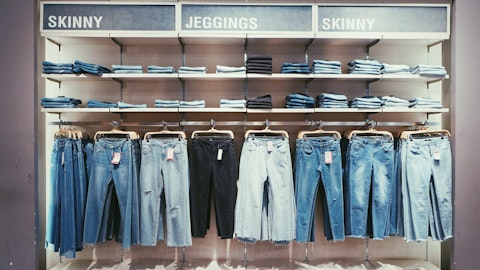Burlington Stores, Inc. (NYSE:BURL) Q4 2022 Earnings Call Transcript March 2, 2023
Operator: Ladies and gentlemen, thank you for standing by and welcome to the Burlington Stores Inc. fourth quarter 2022 earnings webcast. I would now like to turn the call over to David Glick, Group Senior Vice President, Investor Relations and Treasurer. Please go ahead.
David Glick: Thank you Operator, and good morning everyone. We appreciate everyone’s participation in today’s conference call to discuss Burlington’s fiscal 2022 fourth quarter operating results. Our presenters today are Michael O’Sullivan, our Chief Executive Officer, and Kristin Wolfe, our EVP and Chief Financial Officer. Before I turn the call over to Michael, I would like to inform listeners that this call may not be transcribed, recorded or broadcast without our express permission. A replay of the call will be available until March 9, 2023. We take no responsibility for inaccuracies that may appear in transcripts of this call by third parties. Our remarks and the Q&A that follows are copyrighted today by Burlington Stores.
Remarks made on this call concerning future expectations, events, strategies, objectives, trends, or projected financial results are subject to certain risks and uncertainties. Actual results may differ materially from those that are projected in such forward-looking statements. Such risks and uncertainties include those that are described in the company’s 10-K for fiscal 2021 and in other filings with the SEC, all of which are expressly incorporated herein by reference. Please note that the financial results and expectations we discuss today are on a continuing operations basis. Reconciliations of the non-GAAP measures we discuss today to GAAP measures are included in today’s press release. Now here’s Michael.
Michael O’Sullivan: Thank you David. Good morning everyone and thank you for joining us. I would like to cover three topics this morning. Firstly, I will discuss our fourth quarter results; secondly, I will talk about our 2023 guidance; and finally, I’ll offer some comments on our longer term outlook. After that, I will hand over to Kristin to walk through the financial details of our fourth quarter results and our 2023 guidance, then we will be happy to respond to any questions. Okay, let’s talk about our Q4 results. Comp store sales for the fourth quarter decreased 2%. This was on top of 6% comparable store sales growth last year. As we have done on previous calls, today when we are describing our comp trend, we will use a three-year geometric stack.
This metric is defined in more detail in today’s press release. Our three-year geometric stack was positive 4% for the fourth quarter. As we shared on our Q3 call, our three-year geometric stack for November was flat to the prior year. As the quarter progressed, our sales trend improved sequentially. On a one-year basis and a three-year basis, our comp growth in both December and January was positive, with January stronger than December. We believe that there were two drivers of the improvement in our trend. Firstly, we took a number of actions in the back half of last year to sharpen our values. We described these in some detail on our November call, so this morning I am just going to summarize a couple of points. Number one, we backed off our original plan to raise prices.
The consumer and promotional environment changed rapidly last year and it became clear that this was not the right time to be raising prices. Instead, in the fourth quarter we sharpened our values on fresh receipts and we aggressively used markdowns to drive faster turns on existing inventory. We focused especially heavily on expanding opening price points in our assortment. Number two, we significantly raised receipt plans and inventory levels in our strongest businesses and focused this open-to-buy on great opportunistic deals. The off-price supply environment was very strong in Q4 and we were able to take advantage of some incredible buys, especially on branded merchandise. We flowed many of these receipts to stores to fuel the stronger trend and we also tucked away some of these goods in reserve for later release.
These actions worked. Shoppers responded to our sharper values, expanded opening price points, and great branded buys. This led to a significant improvement in customer conversion and in average transaction size; in other words, shoppers liked the values that they found when they walked into our stores. In Q4, we also saw an improvement in traffic. This points to the second driver of our stronger trend. We interpret this improvement in traffic as a sign that the macro headwinds may have started to abate. In particular, although inflation is still elevated, we are beginning to lap the significant spike that occurred in late 2021 into early 2022. Let me move on now and talk about the outlook for the year ahead. As we said in November, we anticipate that in 2023, the economy will slow down and that inflation will continue to fall.
We expect the inventory overhang across retail to diminish and this should lead to less promotional activity. If the external environment unfolds as I have just described, we believe that this could have three major implications for Burlington. First, the economic slowdown should create a greater consumer focus on value, potentially driving some trade-down activity from middle and higher income groups. Second, our value differentiation versus other retailers could grow as promotions moderate, and this should be a tailwind for traffic, conversion and transaction size. Third, we expect that the external expense environment will improve compared to last year. We are already seeing this start to happen with freight rates. There is one other factor that is important to call out, and this one is specific to Burlington.
We executed poorly in 2022 and this hurt our trend. Once we corrected these mistakes late in the year, we saw an improvement. Obviously in 2023, we will be lapping these issues and we expect to drive stronger results. These are the major reasons why we feel optimistic about 2023; but with all that being said, we recognize that there are some uncertainties and potential headwinds ahead. In particular, we remain concerned about the lower income customer, our core customer. In 2022, this customer group bore the brunt of the impact of inflation on real household incomes. We think the impact of inflation will moderate this year but there are other factors that could hurt this customer, such as a rise in unemployment and the ending of expanded SNAP benefits.
Putting all these factors together, we are guiding full year comp sales growth in the range of positive 3% to positive 5%. We believe that there may be upside to this range and we are managing our business to chase potential upside. Given this comp range, we expect to be able to drive 80 to 120 basis points of margin expansion in 2023. As we said in November, we believe we can get back to pre-pandemic margin levels within the next few years, but there are two reasons to be cautious on our 2023 margin. Firstly, our number one priority as we develop our budget and operating plans for 2023 was to drive sales. This means keeping our values as sharp as possible. Given the strong supply environment, we expect an increase in merchant margin, but this is balanced by the need to pass along great value to our customers to drive the trend.

Photo by National Cancer Institute on Unsplash
The second reason to be cautious relates to expenses. As described earlier, we expect the external expense environment, specifically freight rates to improve in 2023, but it is difficult to predict how significant an impact this might have over the full year. Also, as Kristin will explain, in Q4 we incurred higher supply chain expenses as we pushed more aggressively into great opportunistic off-price buys. This merchandise drives sales and value, but it is typically more difficult and expensive to process. For the last couple of years, we have been taking actions to make our distribution centers more off-price and more efficient, but we still have work to do and this work will take time. Let me sum up our 2023 guidance. We are planning and managing our business to support positive 3% to 5% comp growth, but we are ready to chase the trend if it is stronger.
As for operating margin, we believe that we can get back to pre-pandemic operating margins within the next few years. For 2023, we are planning 80 to 120 basis points of expansion on 3% to 5% comp growth. I would like to move on now and talk about our new store opening plans for 2023. We continue to be very pleased by the relative performance of our new stores, especially our new store format. In 2023, we are planning to open 90 to 100 gross new stores. After relocations and closures, this should yield 70 to 80 net new stores. This is lower than we would like and reflects the current lack of high quality real estate locations, as well as supply issues within the construction industry. That said, we believe that this situation could be about to change.
Over the next couple of years, we think that there could be a wave of consolidation in bricks and mortar retail, and we anticipate that this could drive a significant increase in the number of high quality new store locations, so once we get through 2023, we believe that we can grow our new store program such that we will open 500 to 600 net new stores over the following five years. Before I hand over to Kristin, let me make some high level comments about the longer term outlook for Burlington. As I said earlier, we are optimistic about 2023, but looking further out we also see reasons to be bullish about the longer term. There are two factors in particular that I would like to highlight. Firstly, we anticipate that the external environment for full price retail will remain difficult and uncertain over the next few years.
We expect that many traditional retailers may struggle. This should drive strong off-price merchandise supply and, as I mentioned a moment ago, may lead to additional bricks and mortar retail consolidation. In this environment, we believe that off-price retailers have a major opportunity to take share. Secondly, here at Burlington over the last two to three years, we have been busy investing in our business to transform ourselves into a stronger off-price retailer. For example, we have invested in our merchandising capabilities, we have made major changes in our stores organization to be more flexible and off-price, and we have changed our new store prototype to be more productive and efficient. As I acknowledged in November, some of these initiatives are a work in process, but the overall strategic direction is clear: we are working to transform ourselves into a stronger off-price retailer, so as we look beyond 2023, we are very excited.
We believe that the combination of these factors, firstly the potential dislocation and consolidation of traditional retail, and secondly the transformation of Burlington into a stronger off-price retailer could drive significant growth in sales, earnings and shareholder value over the next several years. I would now like to turn the call over to Kristin to provide more details on our Q4 results and our 2023 guidance.
Kristin Wolfe: Thanks Michael and good morning everyone. Let me start with some additional financial details for the fourth quarter. Total sales in the quarter grew 5% while comp sales were down 2%. As Michael mentioned, our three-year geometric comp stack was a positive 4%. Comp sales and adjusted EPS came in above our guidance range. For Q4, our adjusted EPS was $2.96, which was above our guidance range of $2.45 to $2.75. The gross margin rate was 40.7%, an increase of 90 basis points versus 2021’s fourth quarter rate of 39.8%. This was driven by a 130 basis point improvement in freight expense but was partially offset by a 40 basis point decline in merchandise margin. The decline in merchandise margin was primarily driven by higher markdowns a we moved to sharpen our values, as Michael discussed earlier in the call.
Product sourcing costs were $187 million compared to $159 million in the fourth quarter of 2021, increasing 70 basis points as a percentage of sales. This deleverage was primarily driven by higher supply chain costs. We worked a higher mix of true close-out merchandise which is more labor intensive to process. In addition, the movement in and out of our reserve inventory to chase the trend was less efficient and drove higher supply chain expense. Adjusted SG&A was $593 million versus $578 million in 2021, decreasing 50 basis points as a percentage of sales. This was driven by strong expense control and a lower bonus accrual. Adjusted EBIT margin was 10%, 80 basis points higher than the fourth quarter of 2021. Relative to our Q4 2019 adjusted EBIT margin, 2022’s fourth quarter adjusted EBIT margin declined by 340 basis points, driven entirely by supply chain and freight deleverage.
All of this resulted in diluted earnings per share of $2.83 versus $1.80 in Q4 of 2021. Adjusted diluted earnings per share were $2.96 versus $2.53 in the fourth quarter of 2021. At the end of the quarter, our comparable store inventories were 32% above 2021. As a reminder, last year as we came into the spring season, our store inventories were too lean and this hurt our sales trend in Q1, so the significant increase in our comparable store inventories was by design. I should also point out that this is still well below pre-pandemic levels. At the end of the quarter, our reserve inventory was 48% of our total inventory versus 50% last year. We are very happy with the quality of the merchandise and the values we have in reserve. In the fourth quarter, we opened 34 net new stores, bringing our store count at the end of the quarter to 927 stores.
This included 39 new store openings, five relocations, and no closings. For the full year, we opened 113 new stores while relocating 22 stores and closing four stores, adding 87 net new stores to our fleet. I will now move on to discuss our full year 2022 results. Total sales decreased 7% and comp store sales decreased 13%. Our three-year geometric comp stack was flat. Our operating margin for the full year contracted by 370 basis points. Merchandise margin decreased by 110 basis points, freight de-levered by 10 basis points, product sourcing costs de-levered by 120 basis points, and adjusted SG&A de-levered by 110 basis points versus full year 2021. Let’s now move to 2023 guidance. For the 2023 fiscal year, we expect total sales growth in the range of 12% to 14%.
This includes an approximately 2% impact related to the 53rd week. We expect comp store sales to increase in the range of 3% to 5% for fiscal 2023, and our adjusted EBIT margin to increase 80 to 120 basis points versus last year. Capital expenditures net of landlord allowances is expected to be approximately $560 million. This results in adjusted earnings per share guidance in the range of $5.50 to $6, an expected increase of 29% to 41%. This outlook includes an adjusted EPS contribution of $0.05 from the 53rd week. For the first quarter of 2023, we expect total sales growth in the range of 12% to 14%. Comp store sales are assumed to increase between 5% and 7%. We are expecting adjusted EBIT margins to increase in the range of 120 to 150 basis points over the first quarter of 2022, which results in an adjusted EPS outlook in the range of $0.85 to $0.95.
I will now turn the call back to Michael.
Michael O’Sullivan: Thank you Kristin. Before we move to questions, let me recap some of the key points that we have covered this morning. We saw a significant and sequential improvement in our sales trend in Q4. We believe that this was partly driven by better execution, specifically our focus on sharper value but also partly driven by an improvement in the external environment. We are optimistic about the outlook for 2023. We are planning and managing our business for positive 3% to 5% comp sales growth, but we are ready to chase if the trend is stronger. Our number one priority in 2023 is to drive sales. On 3% to 5% comp sales growth, we expect to achieve 80 to 120 basis points of margin expansion. Longer term beyond 2023, we are excited about the prospects for our business.
We anticipate that the next few years will see significant disruption and dislocation across retail. We are pushing forward with the transformation of Burlington into a stronger off-price retailer, and this should help us to take advantage of the opportunities this disruption may present. With that, I would now like to turn the call over for your questions.
See also 16 High Growth Non-Tech Stocks That Are Profitable and 11 High Growth UK Stocks to Buy.
Q&A Session
Follow Burlington Stores Inc. (NYSE:BURL)
Follow Burlington Stores Inc. (NYSE:BURL)
Operator: Our first question comes from the line of Matthew Boss from JP Morgan. Please proceed.
Matthew Boss: Thanks and congrats on a great quarter. Maybe first on your 2023 comp guidance, is there any additional commentary that you can provide on the 3% to 5% comp range, or how should we think about whether there’s potential upside to this range? Then I have a follow-up.
Michael O’Sullivan: Good morning Matt. Thanks for the question. As we developed our 2023 comp guidance, I would say that there was three main reference points that we used. Firstly, we looked at our own multi-year comparisons. I won’t drag you through all the numbers, but we looked at our business on a one-year, a two-year, a four-year basis and we then compared that data with the low single digit annual comp growth that we would historically have expected before the pandemic, so that was the first reference point. Secondly, we looked at our off-price peers. Our comp performance last year was significantly inferior to theirs. Now, we recognize that that may have been partially driven by differences in customer demographics, but we believe it was also driven by significant differences in execution.
We know that we made mistakes last year and in 2023, we certainly don’t intend to repeat those mistakes. Thirdly, the third reference point, if you like, is that we looked at our most recent trend. Our Q4 comp sales were 4% ahead of 2019 levels. Our 2023 comp guide implies that comp sales this year will be 3% to 5% ahead of 2019 levels; in other words, our guide is consistent with Q4. One other data point that I would offer up, though, is that our quarter-to-date trend is running ahead of our Q1 guidance, and that trend gives us additional confidence in our comp guidance. Now, the various points of reference that I’ve just described suggest that our comp guidance for 2023 is achievable, but it’s important to add that there are unknowns out there.
There’s a lot of economic uncertainty and we don’t know how that uncertainty will play out in 2023. I think I’ve said before that setting comp guidance is not an exact science, but in our business that’s okay. If we manage our business flexibly, then if the sales trend is stronger, we know that we can chase higher trend, so I guess I’d sum it up by saying we think our guidance is appropriate but we recognize there may be upside, and if there is, we’re ready to chase it.
Matthew Boss: Great, thanks. Then maybe just a follow-up on your margin guidance. In the prepared remarks, I think you cited 80 to 120 basis points of operating margin expansion on that 3% to 5% comp range. What are the key drivers of expansion, and again, is there a way to think about potential upside to this forecast as well?
Kristin Wolfe: Hi Matt, good morning. Thanks for the question. You’re right – for the full year 2023, we’re guiding a 3% to 5% comp growth, 12% to 14% total sales growth that includes the 53rd week. On that 3% to 5% comp growth, as you said, we’re modeling 80 to 120 basis points of operating margin expansion. This really comes from three main sources: higher merchandise margin, lower freight costs, and leverage on fixed expenses. Let me speak quickly to each of these items. On merchandise margin, given the extremely strong off-price environment, we believe we should be able to see some increase in merchandise margin; but as Michael said in the prepared remarks, our number one goal this year is to drive sales, and that will mean passing along values to our customers.



